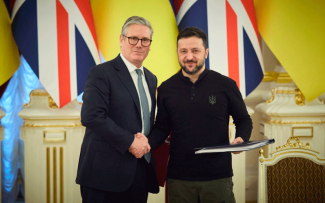Britain pledges a century of support for Ukraine. Day 1063 of the war

![]()
Russian forces are tightening their blockade of Velyka Novosilka, attacking it from three directions. The withdrawal of the remaining defenders there – already possible only through the fields to the northwest – is hampered by the Mokri Yaly River. More villages to the west and south of Pokrovsk have come under the control of Russian troops, and the heaviest fighting is taking place in the area of the mine south of the city’s main supply road (Russia has 5 km left to reach it). The Russians are also continuing to push the enemy out of the salient west of Kurakhove.
The Ukrainians have indirectly admitted that they have lost Toretsk. This is demonstrated by information provided by the Luhansk Operational-Tactical Grouping that much of the city is under Ukrainian fire. A mine on its northern outskirts remains under Ukrainian control. Russia occupied the western part of Chasiv Yar, outflanking the units defending themselves in the centre of the city. It also extended it bridgehead on the right bank of the Oskil River in the vicinity of the junction of Dvorichna, outflanking the defenders in the northwestern part of the town. Ukrainian attempts to eliminate the bridgehead failed, and the Russians remain 2–3 km from Kupiansk. They also recorded further field advances in the direction of Borova and Lyman and in the area of the Ukrainian advance in Kursk Oblast. The Ukrainians, in turn, pushed the enemy back from Sudzha, retaking Makhnovka, which lies to the south of Sudzha.
On January 15 in Warsaw, Volodymyr Zelensky announced that the size of the Ukrainian army now stands at 880,000 soldiers, with 600,000 of them fighting on the Russian side.
![]()
On January 15, Russia launched a missile attack on Ukrainian gas infrastructure. Damage was reported in the vicinity of Drohobych and Stryi in Lviv Oblast (in the latter location, above-ground installations of an underground gas reservoir were targeted), as well as Ivano-Frankivsk, Cherkasy and Kharkiv oblasts. To a lesser extent, electricity infrastructure was hit. According to aggregate Ukrainian data, Russia used 44 missiles for it, of which 31 were neutralised.
On January 16 and 18, Kyiv was targeted by Russia. In the first attack they used drones and damage was reported from five areas of the city. In the second, both Iskander-M missiles used by the Russians are thought to have been shot down, but debris damaged the business centre, a water main and more than ten buildings.
Russian missiles also struck Ukrainian logistics on the immediate frontline. Damage was reported in Kryvyi Rih (January 17), where, according to some sources, a training centre for the Ukrainian army was targeted, in Zaporizhzhia (January 18), Sumy Oblast (January 20), and the Dnipro River and the eastern city of Synelnykove (January 21). In the latter, the railroad junction through which supplies for the defending forces in Pokrovsk pass was targeted.
The Russians continued their massive attacks using strike drones. Damage to energy infrastructure was reported from Poltava Oblast (January 16), Kremenchuk (January 20) and Cherkasy Oblast (January 21). The drones also caused varying degrees of damage to other facilities in the Kirovohrad, Kharkiv and Chernihiv oblasts (January 15), Kharkiv (January 16 and 21), Odesa Oblast(January 17), where the port infrastructure of Izmail, Pavlohrad were targeted (January 18), Kyiv Oblast (January 18, 19 and 21) and Kherson (January 21). From the evening of January 14 to the morning of January 21, Russia is thought to have used a total of 551 drones and, not counting the January 15 attack, 22 rockets. Ukraine declared 346 drones and two rockets shot down, and described 189 drones as locally lost.
![]()
On the evening of January 15, Ukrainian drones caused a fire at a Rosneft fuel depot in Liski, Voronezh Oblast, and two days later in Lyudinovo, Kaluga Oblast. The former was attacked again on January 20, with similar results. Without much success, Ukrainian drones attempted to destroy a number of other facilities, including a fuel base in Tula Oblast (January 18), a chemical plant in Tambov Oblast (January 16), an air plant in Kazan, an airport in the Ryazan region (January 20), and a fuel base and an aeronautics factory in Smolensk Oblast (January 21). According to Russian data, Ukrainians used dozens of drones per day in strikes on Russian territory. The Russians reported shooting down the largest number of them – 95 – on January 16.
![]()
On January 15, the Security Service of Ukraine (SBU) conveyed that, together with the police, it is continuing a nationwide campaign called “Unmask the FSB”, aimed at countering the recruitment of young people by Russian services and preventing arson, terrorist attacks and sabotage. A special chatbot on the Telegram messaging service can be used to provide information about recruitment attempts and indicate the social network or messaging service through which the enemy is operating. Over the past month, the SBU has received more than 1,300 reports of remote recruitment attempts by the Russian special services.
![]()
On January 16, Ukraine and the UK signed a 100-year partnership agreement in Kyiv. In it, they declared that they would extend defence cooperation, including in the sphere of bringing the Ukrainian army up to NATO standards. Among other things, they stressed their intention to develop economic, transportation and energy cooperation. Detailed provisions were included in a separate document – the Declaration of a Centennial Partnership. Among other things, London pledged to provide Kyiv with military aid of at least £3 billion a year until the end of the 2030/2031 fiscal year.
The UK reported that the parties will consider the possibility of deploying and maintaining defence infrastructure in Ukraine, including military bases and logistics depots. The joint production of arms and ammunition was announced, as well as the creation of joint defence businesses. Prime Minister Keir Starmer stated that London will provide Kyiv with 150 artillery barrels (calibre not indicated) and 15 Gravehawk mobile anti-aircraft systems, the manufacture of which is co-financed by Denmark.
The signed documents confirm the UK’s ongoing commitment to supporting Ukraine’s defence capabilities and build on commitments from the January 2024 Security Cooperation Agreement (see ‘The West and Ukraine: agreements on security cooperation’).
The outgoing administration of President Joe Biden has revealed documents about undisclosed support for Ukrainian drone manufacturers, The New York Times reported on January 17. The US investment is thought to have allowed the start and development of the manufacturing of a new generation of drones in Ukraine. As of September 2024, the US had earmarked $1.5 billion to increase its production capacity. The development of the program and contacts between US hi-tech companies and Ukrainian businesses are being overseen by US intelligence officers assigned to Kyiv. Washington is also expected to help Ukrainian entities purchase components for drone manufacturing.
German Defence Minister Boris Pistorius’s visit to Kyiv on January 14 was followed by Germany’s decision to provide Ukraine with an 60 additional missiles for IRIS-T systems from Bundeswehr resources. This was announced on January 15 by the Deutscher BundeswehrVerband. The association noted that these missiles were valued at 60 million euros. This most likely means a further ten missiles to those which Pistorius announced on January 9 during a meeting of a contact group of countries supporting Ukraine militarily. On January 14, Germany also supplemented the list of military armaments and equipment supplied to Kyiv in a broad sense. The Ukrainian army was to receive, among other things: 14,000 155 mm calibre and 19,000 122 mm calibre artillery shells, an unknown number of 105 mm shells for Leopard 1 tanks, 600 HF-1 circulating munitions and 139 reconnaissance drones (50 Vector, 46 Heidrun and 43 Songbird). Berlin has also announced another delivery. It will include 18 RCH 155 self-propelled howitzers on wheeled chassis, along with nine RCT-30 Boxer wheeled infantry fighting vehicles as artillery fire control reconnaissance vehicles and five Marder infantry fighting vehicles.
On January 16, the eleventh package of military support from Italy, which is on its way to Ukraine, was announced by Ukrainian Defence Minister Rustem Umerov, who met with his counterpart Guido Crosetto in Kyiv. A day earlier, the completion of the preparation of the 46th package of Polish aid worth more than 200 million euros was announced Prime Minister Donald Tusk during talks in Warsaw with President Zelensky. It was not revealed what is included in the Italian and Polish military support. In addition, a new package of military aid from Lithuania has arrived in Ukraine, including drones, the country’s defence ministry announced on January 20.
![]()
On January 14, President Zelensky instructed the commander of the Ukrainian Air Force not to direct soldiers of this type to ground troops units. This was in response to reports that infantry brigades were being supplemented by airborne equipment service specialists. The transfer plan is believed to have included about 5,000 men. The Air Force Command of Ukraine provided assurances that personnel highly qualified and trained in the West would not be transferred to other types of armed forces, nor could soldiers serving in mobile air defence units.
On January 19, Commander-in-Chief of the Armed Forces of Ukraine Oleksandr Syrskyi stated that Ukraine’s mobilisation capabilities do not cover the demand of frontline units, so some of the soldiers of the Ukrainian Air Force, who held positions in logistics services, among others, will be diverted to the infantry.
On January 15, member of the parliamentary committee on defenc Oleksandr Fedenko provided assurances that no legislative initiatives to lower the mobilisation age are being considered. Parliamentarians are not expected to be ready to vote on such a move, and the “reserve brigades” do not have sufficient equipment and armaments supplied by Ukraine’s partners.
Ukraine’s law enforcement authorities have uncovered another case of large-scale corruption involving the falsification of documents to avoid military conscription. On January 21, the SBU detained the chief psychiatrist of the Ukrainian Armed Forces adjudicating fitness for service. The official acquired real estate and luxury cars worth a total of more than $1 million between 2022 and 2024. He bequeathed the property to family members. During the search, $152,000 and 34,000 euros were found on him.






